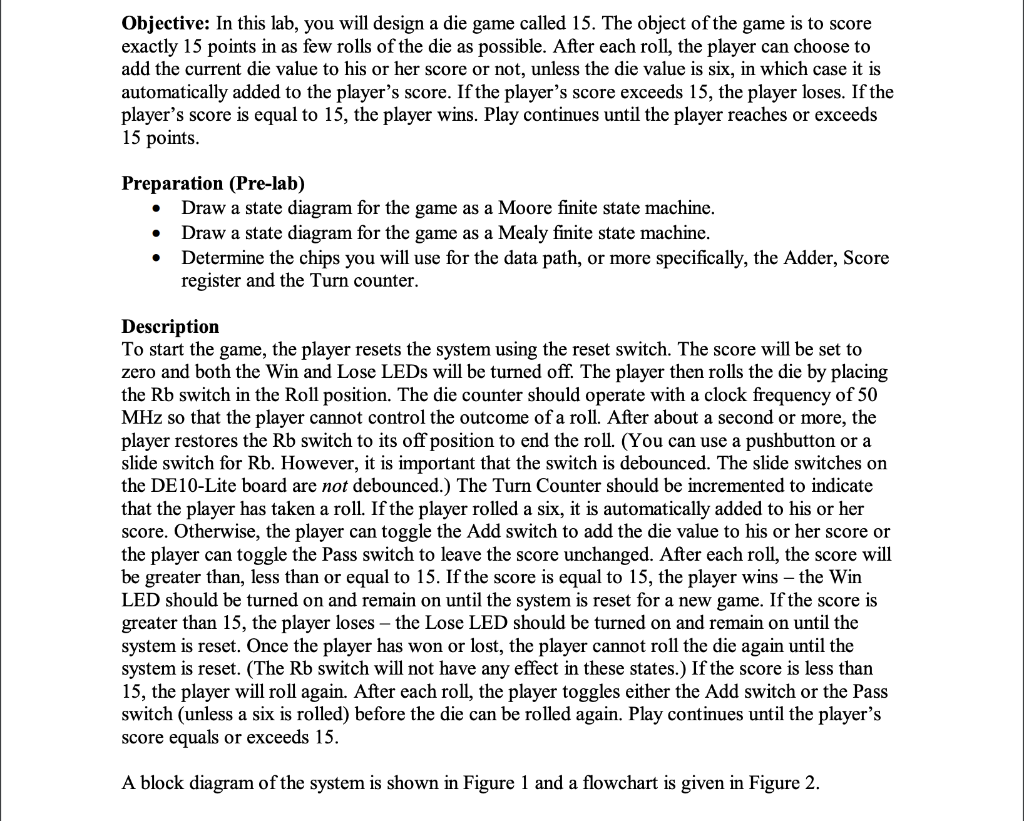Answered step by step
Verified Expert Solution
Question
1 Approved Answer
Can anyone help me draw the mealy state diagram? Thanks! Objective: In this lab, you will design a die game called 15. The object of

Can anyone help me draw the mealy state diagram? Thanks!
Objective: In this lab, you will design a die game called 15. The object of the game is to score exactly 15 points in as few rolls of the die as possible. After each roll, the player can choose to add the current die value to his or her score or not, unless the die value is six, in which case it is automatically added to the player's score. If the player's score exceeds 15, the player loses. If the player's score is equal to 15, the player wins. Play continues until the player reaches or exceeds 15 points Preparation (Pre-lab) * * . Draw a state diagram for the game as a Moore finite state machine. Draw a state diagram for the game as a Mealy finite state machine Determine the chips you will use for the data path, or more specifically, the Adder, Score register and the Turn counter Description To start the game, the player resets the system using the reset switch. The score will be set to zero and both the Win and Lose LEDs will be turned off. The player then rolls the die by placing the Rb switch in the Roll position. The die counter should operate with a clock frequency of 50 MHz so that the player cannot control the outcome of a roll. After about a second or more, the player restores the Rb switch to its off position to end the roll. (You can use a pushbutton or a slide switch for Rb. However, it is important that the switch is debounced. The slide switches on the DE10-Lite board are not debounced.) The Turn Counter should be incremented to indicate that the player has taken a roll. If the player rolled a six, it is automatically added to his or her score. Otherwise, the player can toggle the Add switch to add the die value to his or her score or the player can toggle the Pass switch to leave the score unchanged. After each roll, the score will be greater than, less than or equal to 15. If the score is equal to 15, the player wins - the Win LED should be turned on and remain on until the system is reset for a new game. If the score is greater than 15, the player loses - the Lose LED should be turned on and remain on until the system is reset. Once the player has won or lost, the player cannot roll the die again until the system is reset. (The Rb switch will not have any effect in these states.) If the score is less than 15, the player will roll again. After each roll, the player toggles either the Add switch or the Pass switch (unless a six is rolled) before the die can be rolled again. Play continues until the player's score equals or exceeds I5 A block diagram of the system is shown in Figure 1 and a flowchart is given in Figure 2. Objective: In this lab, you will design a die game called 15. The object of the game is to score exactly 15 points in as few rolls of the die as possible. After each roll, the player can choose to add the current die value to his or her score or not, unless the die value is six, in which case it is automatically added to the player's score. If the player's score exceeds 15, the player loses. If the player's score is equal to 15, the player wins. Play continues until the player reaches or exceeds 15 points Preparation (Pre-lab) * * . Draw a state diagram for the game as a Moore finite state machine. Draw a state diagram for the game as a Mealy finite state machine Determine the chips you will use for the data path, or more specifically, the Adder, Score register and the Turn counter Description To start the game, the player resets the system using the reset switch. The score will be set to zero and both the Win and Lose LEDs will be turned off. The player then rolls the die by placing the Rb switch in the Roll position. The die counter should operate with a clock frequency of 50 MHz so that the player cannot control the outcome of a roll. After about a second or more, the player restores the Rb switch to its off position to end the roll. (You can use a pushbutton or a slide switch for Rb. However, it is important that the switch is debounced. The slide switches on the DE10-Lite board are not debounced.) The Turn Counter should be incremented to indicate that the player has taken a roll. If the player rolled a six, it is automatically added to his or her score. Otherwise, the player can toggle the Add switch to add the die value to his or her score or the player can toggle the Pass switch to leave the score unchanged. After each roll, the score will be greater than, less than or equal to 15. If the score is equal to 15, the player wins - the Win LED should be turned on and remain on until the system is reset for a new game. If the score is greater than 15, the player loses - the Lose LED should be turned on and remain on until the system is reset. Once the player has won or lost, the player cannot roll the die again until the system is reset. (The Rb switch will not have any effect in these states.) If the score is less than 15, the player will roll again. After each roll, the player toggles either the Add switch or the Pass switch (unless a six is rolled) before the die can be rolled again. Play continues until the player's score equals or exceeds I5 A block diagram of the system is shown in Figure 1 and a flowchart is given in Figure 2Step by Step Solution
There are 3 Steps involved in it
Step: 1

Get Instant Access to Expert-Tailored Solutions
See step-by-step solutions with expert insights and AI powered tools for academic success
Step: 2

Step: 3

Ace Your Homework with AI
Get the answers you need in no time with our AI-driven, step-by-step assistance
Get Started


